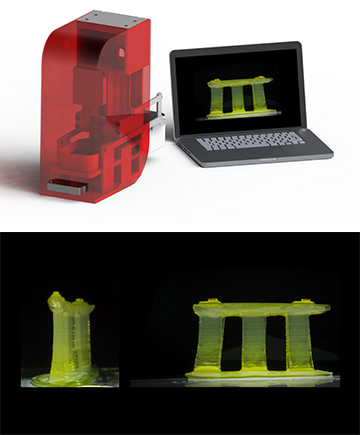
Top: The FLIP 3D bioprinter developed by A*STAR researchers fits on a desktop, and can be controlled with a laptop. Bottom: Complex structures, such as a 3.5-cm tall model of the iconic Marina Bay Sands hotel, can reportedly be printed in less than 10 minutes with cell-compatible hydrogel materials. [Images: Cyrus Beh]
The ultimate goal of tissue engineering is to assemble functional biological structures that restore, maintain or improve damaged tissues or whole organs. Bioprinting has emerged as a possible fabrication technique for this purpose. In particular, 3D printing of hydrogels is considered a feasible way to generate scaffolding for cells to grow.
Researchers from Singapore have now developed a novel approach to 3D printing optimized for hydrogels—one that builds on an existing light-based additive manufacturing process (Biomaterials, doi: 10.1016/j.biomaterials.2021.121034). The approach, called Fluid-supported Liquid Interface Polymerization (FLIP), overcomes challenges faced by traditional 3D printers due to the low mechanical stiffness of hydrogels. The technique’s developers suggest that it could offer a route to fast printing of biocompatible tissues for regenerative medicine.
Taking advantage of buoyant forces
Digital light processing (DLP) technology, originally created for projectors and digital cinema applications, has expanded its usage in recent years to enable a fast, precise form of additive manufacturing. DLP 3D printing works by redirecting light from a UV or visible source with an array of micromirrors to project an image of a desired pattern. A vat of liquid photopolymer is exposed to this pattern of light and cured, layer by layer, until the final structure is complete.
Cyrus W. Beh and his colleagues adapted DLP 3D printing for the assembly of soft hydrogels, which can sag or collapse during fabrication due to inadequate support. The FLIP 3D printer, which uses a 405-nm UV projector, floats a thin layer of liquid hydrogel precursor atop a denser, immiscible support fluid to provide buoyant forces. The support fluid is easily removed by rinsing the structure afterwards.
“In our method, the nascent print is surrounded by fluid, which provide buoyant forces that allow overhung or suspended structures to be printed without requiring additional support structures,” said Beh, principal investigator at the Singapore Agency for Science, Technology and Research’s (A*STAR) Institute of Bioengineering and Bioimaging. “We saw its potential to address challenges faced by conventional, extrusion-based bioprinters, such as slow printing and the difficulty in printing with soft hydrogel materials.”
A step toward engineered tissues
Because patterns are projected directly onto a floating liquid projection screen, FLIP 3D printing prevents adhesion of the printed structure to the patterning window (an LCD screen, in typical resin-based 3D printers). The process thus eliminates an additional lifting step between layers that slows down the process. As a result, FLIP 3D printing can work faster than conventional DLP, ensuring that cells can more quickly return to the optimal culture conditions.
To verify the technique, the researchers printed a range of complex soft structures, including unsupported geodesic domes, anatomical structures, and 3D lattices. They also tested the biocompatibility of the method, directly printing cells in gelatin methacrylate (GelMA)-based bioink, which demonstrated no adverse effect on the cells.
“Our preliminary results indicate that bioprinting of cells can be accomplished with our method,” said Beh. “We are currently investigating long-term culturing and differentiation of bioprinted cells, as well as novel microvascularization strategies, as a way to create viable tissues for regenerative medicine purposes.”
